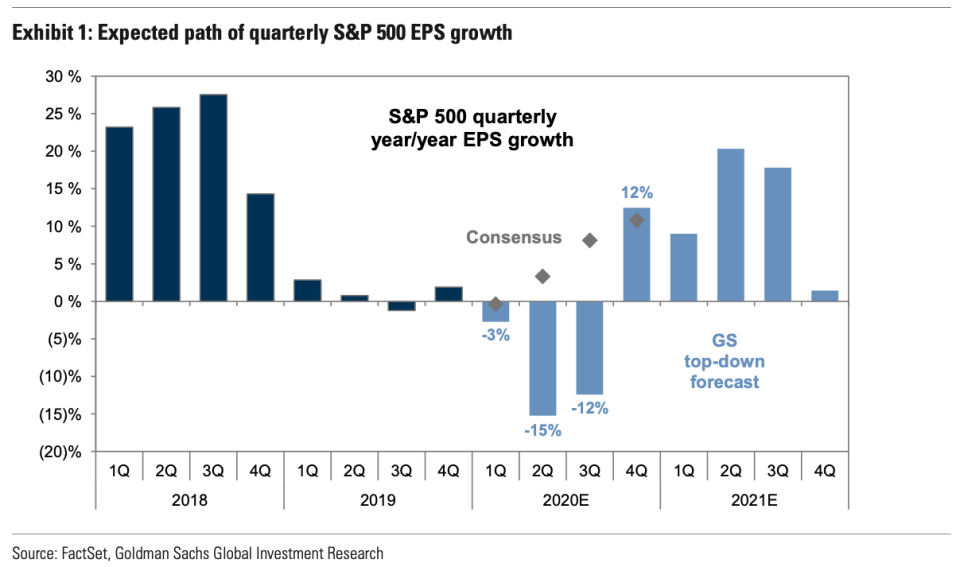Goldman Sachs says the bull market is over
The coronavirus outbreak has sent financial markets into chaos.
And David Kostin and the equity strategy team at Goldman Sachs think this market sell-off will serve as the end of the post-crisis bull market.
“After 11 years, 13% annualized earnings growth and 16% annualized trough-to-peak appreciation, we believe the S&P 500 bull market will soon end,” Goldman said in a note to clients published Wednesday.
“On February 27th we lowered our 2020 S&P 500 EPS estimate to $165. We are now reducing our profit forecast again.”
Goldman currently expects that year-over-year earnings per share for S&P 500 companies will drop 15% in the second quarter and 12% in the third. Current consensus expectations are for an increase of 3% and 8% in each of these quarters, respectively.
The firm thinks the S&P 500 will drop another 15% over the next three months and bottom at 2,450. Shortly after Wednesday’s open, the S&P 500 was off some 2.6% and was trading below 2,800.
By the end of 2020, however, Goldman expects a sharp rebound in the benchmark index with the S&P 500 finishing the year at 3,200, some 31% higher than the forecasted trough.
“Drivers of our reduced EPS estimate include lower crude oil prices and interest rates that diminish Energy and Financial company profits,” Goldman said.
“Domestic business activity outside of those sectors is also likely to be weaker than we originally forecast, as underscored by reduced or withdrawn guidance from a number of firms in recent weeks.”

On Monday, the market suffered its worst day in more than a decade with the S&P 500’s 7.6% drop serving as its largest since December 2008 while the Dow shed some 2,014 points, or 7.8%, the index’s largest point drop on record.
A collapse in the price of oil on Monday spurred by a price war between Saudi Arabia and Russia pressured energy names to start the week. Goldman now estimates earnings per share for S&P 500 energy companies will drop by 50%. Energy names account for 2% of the S&P 500’s forecasted 2020 earnings.
The incredible move in the Treasury market also puts financial firms under pressure, with the 10-year and 30-year Treasury yields both hitting record lows earlier this week.

Unlike energy, however, financials play a much larger role in the earnings picture for the S&P 500, accounting for 19% of the index’s earnings per share, according to Goldman. Lower Treasury yields and expected additional interest rate cuts from the Federal Reserve lead the firm to reduce its earnings per share estimates for financials by 5%.
Goldman does note that the market has gotten cheaper during this market decline, but expects a further de-rating of the S&P 500 before the market troughs.
As Yahoo Finance’s Sam Ro highlighted Wednesday morning, the S&P 500 now trades near 16x forward earnings, down from around 19x earnings at the start of the year.
“The S&P 500 multiple just experienced one of the largest multiple de-ratings in the last 30-years,” JPMorgan’s Dubravko Lakos-Bujas said Tuesday in a note to clients. “Over the last 1-month its multiple de-rated by ~3.5 turns, which is comparable to the dot com bubble recession and the global financial crisis.”
Goldman expects the S&P 500 will trough with its forward multiple around 14x, but return to a multiple around 18x by year-end as the index rebounds sharply.
“Our baseline forecast assumes the COVID-19 shock to economic activity and sentiment is ultimately short-lived and the headwind fades,” Goldman writes.
“Under this scenario, by year-end economic and earnings growth will be reaccelerating, the fed funds rate will be at the zero lower bound, the impact of fiscal stimulus will be flowing through to consumers, and political uncertainty will abate following the US elections.”
For his part, Lakos-Bujas also expects the S&P 500 to trade down to a multiple around 13x-14x forward earnings in a recessionary scenario, sending the benchmark index to around 2,300. But even under these circumstances, Lakos-Bujas is relatively optimistic.
“Even in such a downside scenario we expect earnings recession to be relatively shallow by historical standards,” Lakos-Bujas writes, “given relatively healthy balance sheets of US consumers and key corporate sectors.”
—
Myles Udland is a reporter and anchor at Yahoo Finance. Follow him on Twitter @MylesUdland
Read the latest financial and business news from Yahoo Finance
Follow Yahoo Finance on Twitter, Facebook, Instagram, Flipboard, SmartNews, LinkedIn, YouTube, and reddit.
For tutorials and information on investing and trading stocks, check out Cashay
